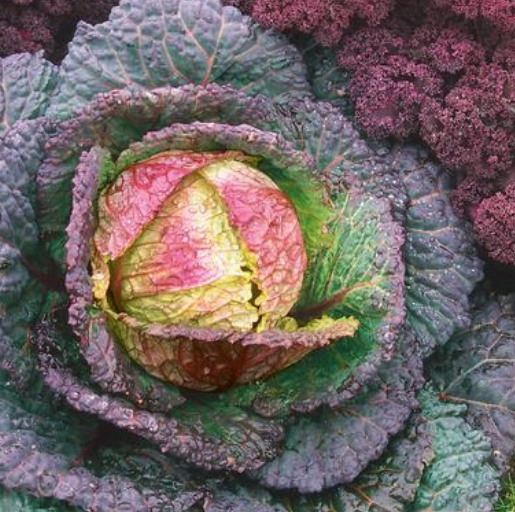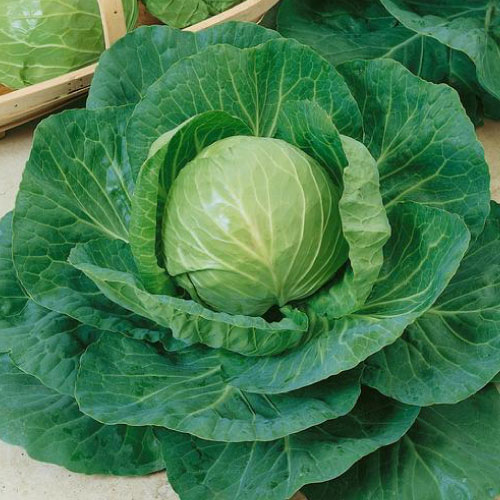
Learning Download: How to Grow Cabbage
From Seed to Harvest: A beginner’s guide to growing cabbage.
Cabbage is a fairly easy to plant to grow, as it is a hardy vegetable, and also comes in different colors, such as red, green and white. Most cabbages will have smooth, tightly packed heads of leaves, but some varietals have crinkled leaves. Cabbage belongs to the Cole Crop family, like broccoli and Brussels sprouts and has more vitamin C than oranges.
To plant:
Cabbage is cold hardy and can be planted four weeks before the last frost, but plants should be protected from harsh winter weather. For a fall harvest, plant six to eight weeks before the first frost. When transplanting, bury about one to two inches of the stem. Plant 15 to 18 inches apart. For optimum harvesting, plant a few different varietals of cabbage depending on their harvest times to have cabbage all season long.
To grow:
Cabbage plants do better when planted near herbs like dill and rosemary. Cabbage can be damaged by cabbageworms, and to deter these, use row covers while the plants are young. Fertilize plants with a high-nitrogen fertilizer, and be sure to water evenly, as uneven water can split the heads. Cut back on watering as cabbage reaches maturity, as this also can split the heads. Avoid planting cabbage near strawberries, tomatoes or pole beans.
To harvest:
Cabbage heads are ready for harvest when the head is firm and its interior is dense. Harvest before the plant splits. When cabbage is ready to harvest, the base of the head will be four to six inches across. When you cut the heads, leave the leaves on the stem behind. Smaller heads may grow again for a later harvest.
What cabbage craves:
Cabbage grows best in a soil with a pH between 6.5 and 6.8, and it should be grown in full sun. It prefers even moisture of about 1 or more inches per week. Mulching helps with providing even moisture. To prevent disease in the future, alternate cabbage and other vegetables that aren’t members of the Cole crop family each year. It grows best in climates where there is a long cool season, such as temperatures between 45 and 75 degrees.
Where to buy cabbage seeds:
You can find different varietals of cabbage seeds, including red, purple and green kinds at Urban Farmer.
Learning Download: Common pests and diseases: Cabbage
Common pests and diseases: Cabbage
When growing vegetables, it is always exciting to care for the plant throughout its growing phase and then harvest it for delicious recipes later on, but one thing to watch out for is pests and diseases. Different plants are susceptible to different types of pests and diseases, and it is important to make yourself aware so you can keep a watchful eye and also take any preventative methods to keep your plants safe throughout their lifespan.
Cabbage can fall victim to several different pests and diseases.
Pests:
One of the most popular insects affecting cabbage is the cabbage worm. This insect also affects other members of the Cole family, such as broccoli.
Cabbage worms are the larvae of the moths and butterflies. If you see white or gray moths around your cabbage plants, that could be proof later on, you’ll have problems with the cabbage worms. The cabbage worms feed on the broccoli leaves, which can then cause serious damage. If you see them on the leaves, hand-pick them to remove them. You can also control the younger larvae with certain insecticides that contain Bacillus thuringiensis or spinosad.
Cabbage loopers are another popular pest that harms the cabbage plants. You can typically find them on the undersides of the leaves or along the leaf margins. They are light green and will typically feed on the leaf in between the leaf’s veins. Apply your treatment early on because the cabbage loopers are more difficult to treat the older they are. You can also use pheromone traps to detects the adult cabbage looper’s presence.

Aphids are another pest that can harm cabbage plants. They are tiny insects with soft bodies, and they feed on the broccoli leaves’ undersides. They will cause the leaves to wrinkle or become discolored. Spray the insects with water from the hose and that will knock them off. Use insecticidal soap or neem oil to treat the infestations.
Another pest affecting cabbage plants is the flea beetle. Flea beetles are small, black insects which causes holes in the foliage of the plant. If flea beetles continue to feed, it can kill seedlings or, if the plants are older, reduce the yield. To treat, use insecticides that are specifically for flea beetles. The beetles can overwinter in the soil, so to prevent that issue, make sure you clean up your end of the season crop well.
Cutworms are another popular pest affecting cabbage, and they usually feed at night. To prevent this, you can plant seedlings instead of seeds and wrap collars around the stems to protect them.
Diseases:
Cabbage plants are mostly affected by bacterial and fungal diseases, like downy mildew which attacks both the seedlings and the adult plants. The plants affected by this disease develop mold on the lower part of the leaf’s surface. The upper part of the leaf will then turn brown and die. The best way to prevent this disease is to rotate your crops so that you don’t plant Cole family crops in the same place more than once every three years.
Learning Download:
Cabbage Comparison Chart
| Variety | Days to Maturity | Size | Color | Resistance |
| All Seasons | 87 | 11-14 pounds | Light green | Heat and yellowing resistant |
| Blue Lagoon | 68 | 3-5 pounds | Blue to blue green | Black Rot and Downy Mildew resistant |
| Bravo | 85 | 6-9 pounds | Blue green | Black Rot and Fusarium Yelllows resistant |
| Brunswick | 88 | 6-9 pounds | Medium green | |
| Copenhagen Market | 65 | 3-4 pounds | Dark to light green | |
| Danish Ballhead | 85-100 | 5-7 pounds | Blue green | |
| Early Jersey Wakefield | 60 | 2-3 pounds | Light green | |
| Early Round Dutch | 85 | 10-15 pounds | Blue green | |
| Golden Acre | 62 | 2-3 pounds | Medium green | Yellow resistant |
| Green Express | 50 | 2-3 pounds | Light green | |
| Ip Ssam Hong | 65 | 2-3 pounds | Light green | |
| Late Flat Dutch | 100 | 10-15 pounds | Blue green | |
| Michihili | 75-80 | 2-3 pounds | Light green | |
| Red Acre | 75 | 2-3 pounds | Red | |
| Red Express | 53 | 2-3 pounds | Red | |
| Savoy Perfection | 90 | 6-8 pounds | Medium green | |
| Stonehead | 70 | 3-6 pounds | Light green | Fusarium Yellows, Tip Burn and Yellow resistant |
| White Stem | 45-60 | 2-3 pounds | Dark green |

